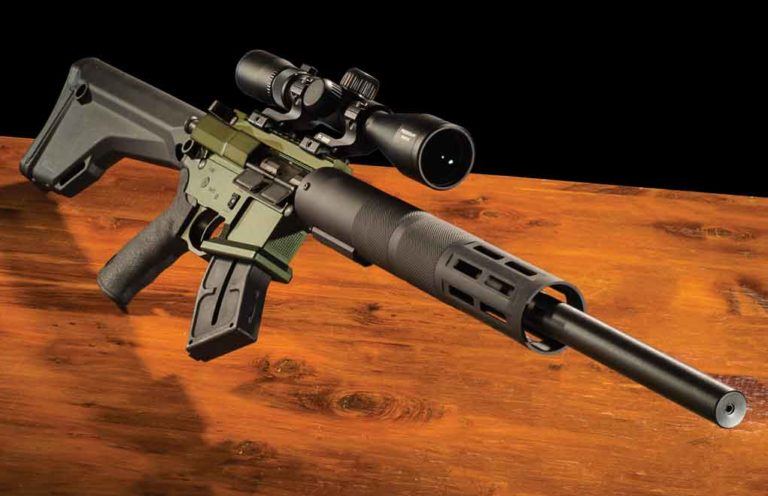
Franklin Armory’s F17-L is a rimfire AR that offers performance above its weight class.
How this hot little number sizes up:
- Released in 2014, the F17-L followed on Winchester's introduction of the .17 WSM.
- For a time, the F17-L was the only gas-operated semi-automatic .17 WSM in an AR-type platform.
- It utilizes a custom-designed bolt-carrier group, and adapted buffer and proprietary magazine.
- It is gas-piston operated, since a simple blowback system isn’t equipped to handle the .17 WSM’s pressure.
- In testing at 100 yards, the best groups (1.65″ average) came with 20-grain Hornady V-Max.
- The MSRP of the F17-L is $1,999.
For some time now, Franklin Armory has been producing quality AR-style rifles, SBRs, pistols and parts, with a special emphasis on crafting legal firearms for citizens of states with restrictive gun laws. These laws, enacted under the guise of improving safety, essentially strip away many of the modern sporting rifle’s most appealing features. While some debate whether gun makers should even build firearms to fit these laws, the California-based Franklin Armory has resolved to make lemonade with lemons.
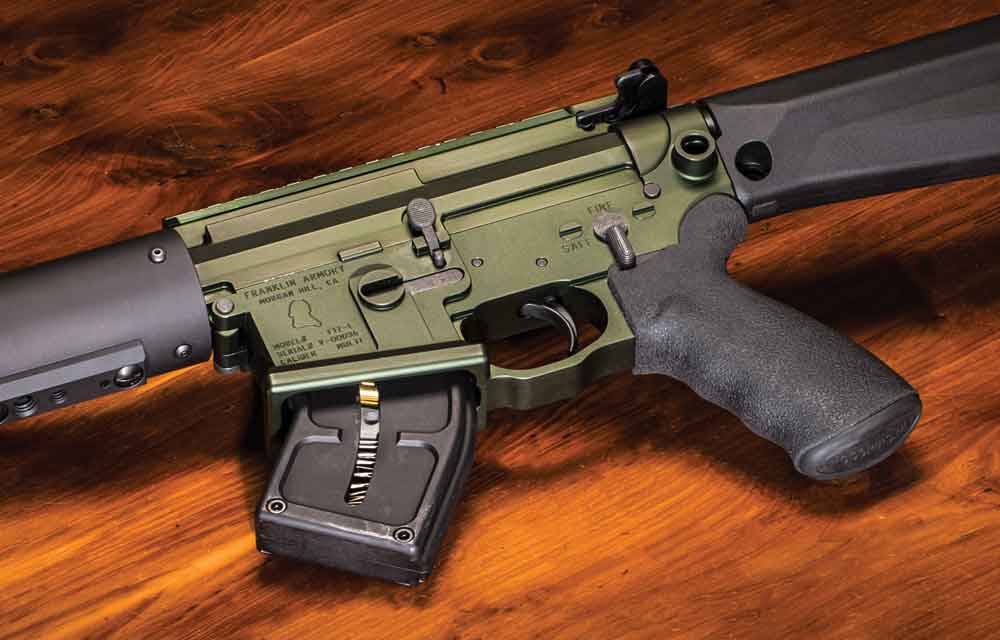
Over the years, the company has become quite adept at working within the confines of restrictive laws while also skirting the edges on its designs. Although it also manufactures full feature firearms for free states, some of its most intriguing products are those that seek to liberate shooters stuck behind enemy lines. One of these is the F17-L rifle.
Bridging the Gap
First introduced at the 2014 SHOT Show, the F17-L followed on the heels of Winchester’s introduction the previous year of the .17 Winchester Super Magnum (WSM). Winchester developed this unique cartridge by taking what was then a .27-caliber nail gun blank and necking it down to accept a .17-caliber projectile. The results were impressive, with the .17 WSM spitting a 20-grain bullet at velocities around 3,000 feet per second (fps), roughly 625 fps faster than the popular .17 HMR and very near those of centerfire .223/5.56 NATO loads pushing a 62-grain projectile.
This innovative new design closed the distance between rimfire and centerfire cartridges—at least in terms of velocity inside 200 yards (the lighter bullets shed velocity quicker). And at the time, the F17-L was the first and only semi-auto chambered in .17 WSM. Volquartsen developed one, but the F17-L remained the only gas-operated semi-automatic .17 WSM in an AR-type platform.
What this meant was that shooters in non-free states could now buy a street legal rimfire AR with a lot more punch than those chambered in .22 LR. Because there were fewer restrictions on rimfire rifles, the F17-L escaped regulations like the much-maligned “Bullet Button,” a device that requires a tool in order to swap out an otherwise easily detachable magazine.
For these reasons, the F17-L remains an excellent option for those who can’t own a standard AR. However, it’s also a great gun for those in free states as well.
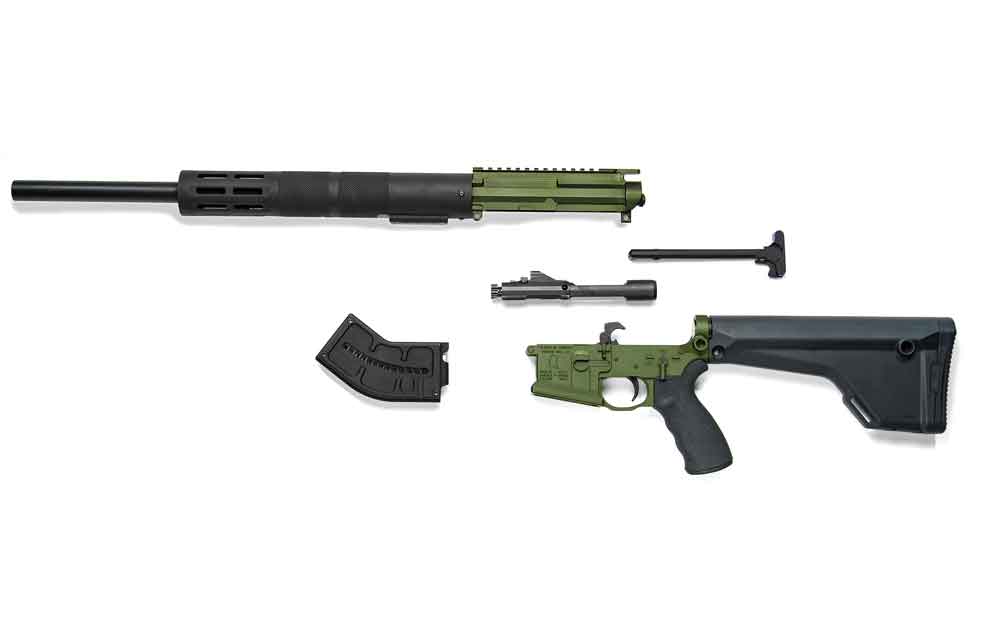
Making It Work
To accommodate the .17 WSM chambering, Franklin Armory had to make several changes from standard AR designs. For starters, the rifle utilizes a custom-designed .17 WSM bolt carrier group, a .17 WSM barrel, an adapted buffer and a proprietary magazine. Obviously, without these necessary alterations, the concept would be dead in the water.
However, another important design choice by Franklin Armory is its use of a gas-piston operating system. A simple blowback system isn’t equipped to handle the pressures of the .17 WSM (33,000 PSI) and, as most shooters are aware, rimfire ammo often runs incredibly dirty through a firearm, to the point of causing functional issues if the gun is not maintained regularly. With the cleaner gas-piston system, Franklin Armory is able to handle the higher pressures and keep the F17-L running smoother, longer.
The gas system found in the gun is of the pistol-length variety, which Franklin Armory determined works best with the .17 WSM. The system itself is the result of a partnership between Franklin Armory and Osprey Defense, which specializes in drop-in gas-piston conversion kits for ARs.
The aforementioned proprietary magazine, which features an aluminum design, holds 10 rounds and has a curved shape for compatibility with the rimmed .17 WSM. This curve, while not too dramatic, does slightly affect loading. The magazine’s interchange with the magwell isn’t butter-smooth, but neither does it require significant effort to slide it into place. The magazine is also somewhat difficult to load, especially after about the sixth round, but there’s a circular slot in the follower where you can use a cleaning rod, screwdriver or some other tool to compress the spring for easier loading.
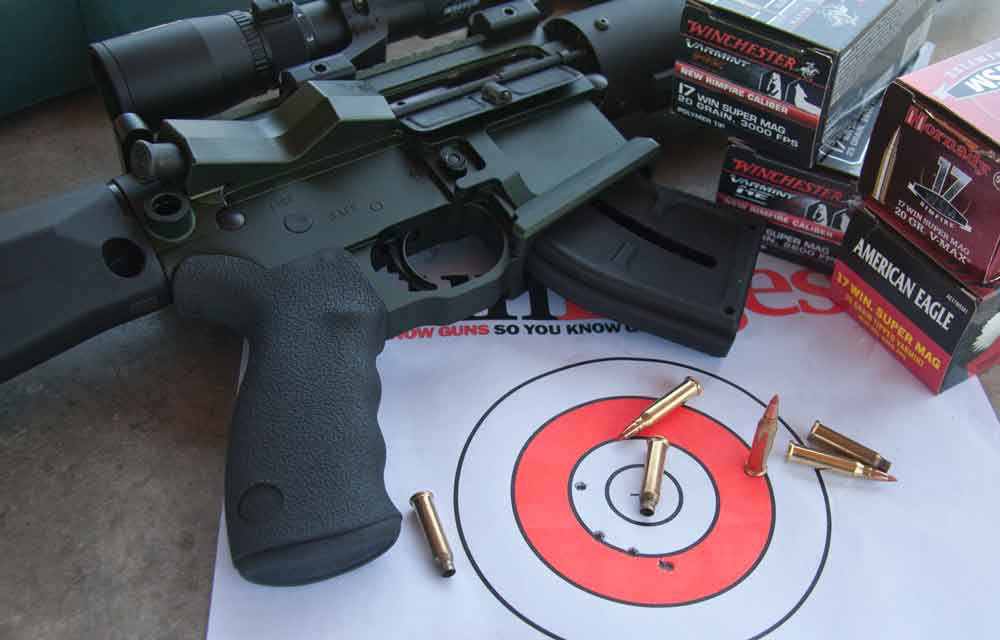
The F17-L features 7075-T6 billet aluminum upper and lower receivers, which are also a proprietary design. They receive a stylish and durable hard coat anodized Olive Drab Green finish, instantly distinguishing this gun in the sea of black rifles. The upper receiver has a forward assist; however, its use with the rimfire chambering is problematic and the F17-L’s user manual details these risks in full. The lower is equipped with useful features such as a flared magwell for easy loading and an enlarged trigger guard for gloved shooting, something dedicated varmint hunters are sure to appreciate.
While the upper and lower of the rifle incorporate many of the controls and features AR users are accustomed to (charging handle, magazine release, safety selector, forward assist, bolt release), not all of these function the same way. The forward assist has been mentioned, but there are other changes, too.
For example, the carrier does not lock back on an empty magazine, nor is there a way to keep the bolt held open, which is slightly baffling when you first pick up the rifle and try to hold the action open in the usual fashion. This is partly because of the altered buffer mentioned earlier, which is about 1 inch longer than a standard buffer, and this is due to the decreased distance the bolt carrier has to travel for the shorter rimfire cartridge.
The rifle utilizes a 1:9 twist, 20-inch bull barrel that receives a salt bath nitride treatment and comes with a target crown. The barrel is set inside a free-floating aluminum handguard that is fluted and vented and offers M-Lok compatible slots as well as an integral bipod/tripod adaptor.

The F17-L stock is a Magpul MOE Rifle Stock, which is smooth to shoulder and sling mountable. Meanwhile, the grip is a comfortable and sturdy Ergo Ambi Sure Grip that, when paired with Franklin Armory’s Factory Custom Tuned Trigger, makes for an excellent package.
Range Performance
The F17-L is built to be a varmint slayer, and for testing, I equipped the rifle with a Nikon Prostaff Rimfire II 3-9×40 BDC 150 scope, which features Nikon’s BDC 150 reticle. While the reticle is set up for high-velocity .22 LR loads, using Nikon’s Spot On website and ballistics program, you can plug in the caliber and load you prefer, and it will tell you what each of the drop markers represent in terms of trajectory for a given zero.
I used four loads during testing: Winchester’s 25-grain Varmint HE and 20-grain Varmint HV, Hornady’s 20-grain V-MAX and American Eagle 20-grain tipped varmint loads. Velocities were measured through a ProChrono Chronograph from Brownells about 10 feet from the muzzle. Accuracy data for each load was acquired from three, five-shot groups taken at 100 yards using a Caldwell Matrix rest, also from Brownells.
During much of my time with it, the rifle ran without fault, but I did run into a few issues as testing progressed. I encountered some light primer strikes. Also notable, in several instances the rifle failed to extract spent cases; occasionally, cases would become stuck within the barrel, which would then naturally lead to misfeeds as the gun attempted to chamber another round.
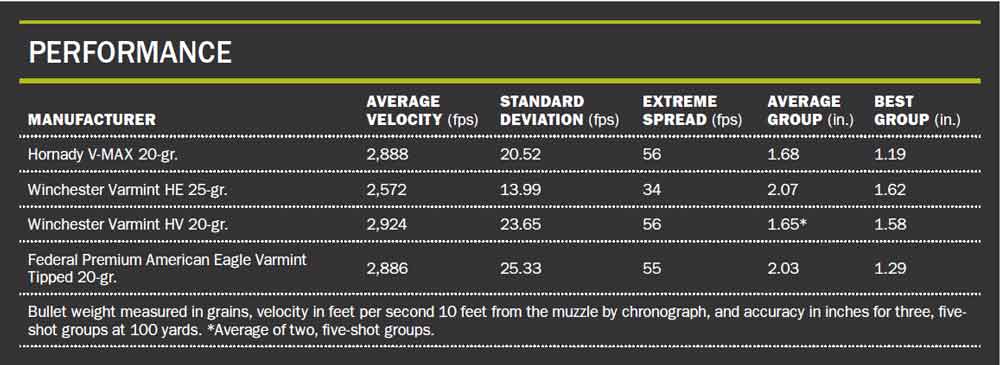
Aside from these issues, however, I was very impressed with the F17-L. Groups were decent, despite the stout wind during testing. The 20-grain Hornady V-MAX posted the best group overall at a respectable 1.19 inches, while the Winchester 20-grain Varmint HV load rated the best average at 1.65 inches. The other loads had best groups hovering between 1.2 and 1.6 inches or so.
Parting Shots
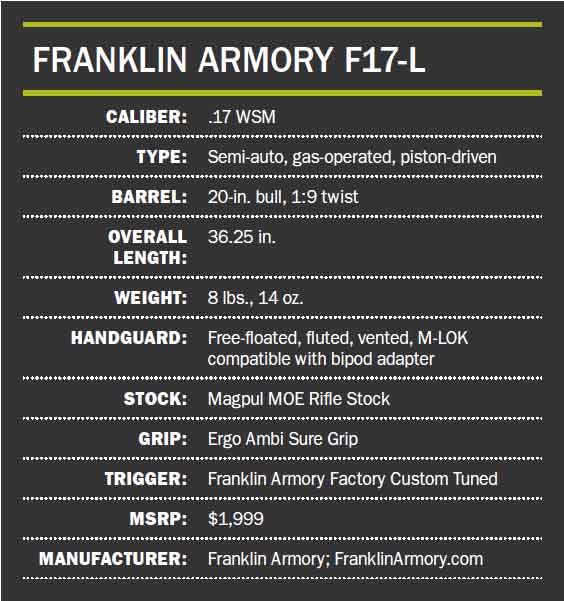
Built partially to meet the needs of shooters in restrictive states, the F17-L excels in that capacity. It’s a unique design that remains a first for the firearms industry, taking the blistering little .17 WSM and working it into the semi-auto AR platform. Because of the looser restrictions on rimfires, residents of states like California can get an AR-type rifle with all the AR’s great features and with more bite than the .22 LR. Meanwhile, hunters in free states are also sure to love a semi-auto .17 WSM that can pot varmints at greater distances and with more authority than other rimfire calibers. All in all, the F17-L is an innovative design that stretches the boundaries of what is possible with rimfire ammunition and with the AR platform.
Editor's Note: This article originally appeared in the July 2016 issue of Gun Digest the Magazine.

Next Step: Get your FREE Printable Target Pack
Enhance your shooting precision with our 62 MOA Targets, perfect for rifles and handguns. Crafted in collaboration with Storm Tactical for accuracy and versatility.
Subscribe to the Gun Digest email newsletter and get your downloadable target pack sent straight to your inbox. Stay updated with the latest firearms info in the industry.

![Best Concealed Carry Guns In 2025 [Field Tested] Wilson Combat EDC X9S 1](https://gundigest.com/wp-content/uploads/Wilson-Combat-EDC-X9S-1-324x160.jpg)


![Best 9mm Carbine: Affordable PCCs [Tested] Ruger Carbine Shooting](https://gundigest.com/wp-content/uploads/Ruger-Carbine-Shooting-100x70.jpg)
![Best AR-15: Top Options Available Today [Field Tested] Harrington and Richardson PSA XM177E2 feature](https://gundigest.com/wp-content/uploads/Harrington-and-Richardson-PSA-XM177E2-feature-100x70.jpg)

Really shouldn’t use accuracy data derived from a windy day… Thanks just the same.